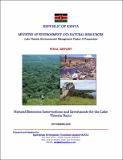Natural Resources Interventions and Investments for the Lake Victoria Basin
Author
Date
2006Type
Reportviews
downloads
Metadata
Show full item recordxmlui.dri2xhtml.METS-1.0.item-citation
Natural Resources Interventions and Investments for the Lake Victoria Basin
Abstract/
The Lake Victoria Environmental Management Project Phase I The Lake Victoria Environmental Management Project Phase I (LVEMP I) was implemented in Kenya, Uganda and Tanzania since July 1997. The Project was executed by the National Secretariats under the auspices of the East African Community. The International Development Agency (IDA), the Global Environment Facility (GEF) and the three East African Community Partner States (Republics of Kenya and Uganda and the United Republic of Tanzania) funded the Project. The Lake Victoria Basin is rich in natural resources including fishery, which is a major economic resource for the three riparian states. It is estimated that 30 million people live within the Basin with 3 million depending directly on the fisheries resources. On the Kenyan side, the LVEMP I geographically covered the whole of Nyanza and Western Provinces and twelve districts of the Rift Valley Province. The objectives of the project were to: Maximize sustainable benefits of the riparian communities by using resources within the Basin to generate food, employment and incomes, supply safe water and sustain a disease free environment; Conserve biodiversity and genetic resources for the benefit of the riparian states and the global community; Harmonize national and regional management programs in order to achieve, to the maximum extent possible, the reversal of environmental degradation; and Promote regional cooperation Phase I of the Project operated within the policy framework of each of the three Partner States. The Project implemented components of catchment afforestation, land use management, management of wetlands, water hyacinth control, management of industrial and municipal waste, water quality control, integrated soil and water conservation, fisheries research and management, capacity building and micro projects. Some of the critical issues that affected effective and efficient management of the project include; lack of clear understanding by the implementing partners on the overall objective and expected impact of the Project, lack of clear logical frameworks prior to project implementation, lack of a thorough needs assessment, lack of baseline information, inadequate gender sensitivity, conflict in coordination, convoluted procurement procedures, and lack of adequate knowledge on financial management procedures. Key lessons learned included: (i) a comprehensive Lake Basin perspective is necessary for tackling environmental degradation of the Lake Victoria; (ii) applied research is critical for generating knowledge of the Lake Victoria basin ecosystem, developing technological responses, and guiding management decisions, but must be targeted and practical; (iii) communication of research findings and pilot results to policy makers, managers, and stakeholders in a language that they do not understand impedes taking management decisions; (iv) knowledge must be complemented by strong institutions, policies, and regulatory framework for coordination and sustainable management of transboundary natural resources, and addressing the associated environmental concerns; (v) project outcomes/results cannot be captured in the absence of a robust M&E system, based on a clearly defined logical framework; (vi) involvement of communities in the watershed management is a prerequisite to successful control of non-point sources of pollution; and (vii) uncoordinated inteventions of multiple donors raise costs of development assistance and dissipate impact. Some of these lessons were derived from disappointments as well as successes occuring during the first phase.

